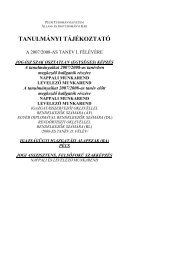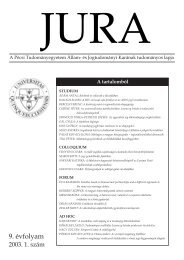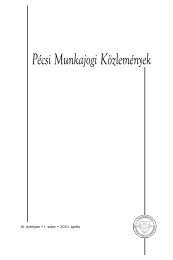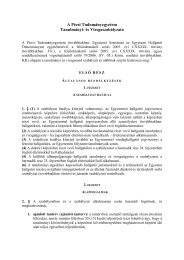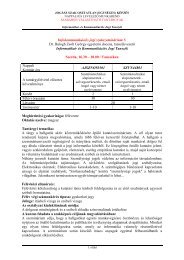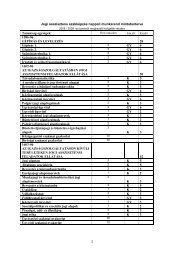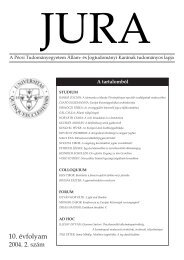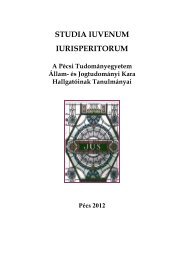2012. évi 2. szám - Jura - Pécsi Tudományegyetem
2012. évi 2. szám - Jura - Pécsi Tudományegyetem
2012. évi 2. szám - Jura - Pécsi Tudományegyetem
- TAGS
- jura
Create successful ePaper yourself
Turn your PDF publications into a flip-book with our unique Google optimized e-Paper software.
144 Andityas Soares de Moura Costa Matos: An alternative approach to the basic norm …ring power-law” (Raz 2007, 51) –, opens the doorsfor the exercise of thought. The presupposed basicnorm does not have the same ontological status asothers norms of the system, which are established.For indicating the possibility and the logical validityof the legal system, the basic norm is transpositiveand transcendental, but not metaphysical ortranscendental (Goyard-Fabre 1991, 123). Thus, thelogical-cognitive operation always begins at the possibilityof concretely thinking the basic norm, whichbrings us to the second condition of assumption, thatis, indeed, of factual nature. It can be summarized inthe overall effectiveness of the legal system, whichsomehow connects Kelsen’s deductivism to thenecessary minimum of empiricism for any scientificthought system, as expressed by Arendt while commentingon the sui generis theory of knowledge of thepoet and philosopher Hermann Broch. His wordsseem to have been written to explain the necessity ofoverall effectiveness in Kelsen’s legal order, as wellas its nature of a scientific postulate, a topic that weaddress below: […] there is no correspondence toan absolutely deductive system. Rather, the basis ofany formal system is always empirical. This meansthat the whole system rests on more a transcendentfoundation, which is necessary to postulate as absolute,otherwise, the system could not even begin itsvarious deductive chains (Arendt 2008, 156).The jurist can assume the basic norm of a certainlegal order only when he is before a generally effectivecoercive system. The need for overall effectivenessfor the assumption of the basic norm has ledmany critics, such as Mario Lausanne, to argue thatKelsen had disrespected the division between theworld of “is” and the world of “ought”, since, afterall, the norm which gives validity to every legalsystem would depend on a fact of the “is” order. 10Similarly, Bobbio identifies the basic norm as thefounding act of the legal order, so that the legalitywould be founded through the imposition of the coercivepower. None of these alternatives is consistentwith Kelsen’s logical normativism. If it is true thatthe gap between facticity and normativity seems tobe insurmountable, it is also true that the bridge capableof allowing such crossing is based on the basicnorm (Honoré 2007, 102). The legal system consistsof a unitary and systematic aggregate of norms, nota concatenation of events that, in the end, rest overpower (Luf 2007, 222). All the theories that seek toground of validity of law in its effectiveness aredevoid of scientific value, given that these doctrinesdisregard the basic standard according to which anorm can only be based on another norm and a facton another fact. This means, in Kantian language,that an “ought” can only be established by another“ought” in the same way that an “is” emerges fromanother “is”. Otherwise, we would have to acceptas valid the “naturalistic fallacy”, namely the beliefthat the value (norm/“ought”) arises from reality(fact/“is”), which is absolutely unacceptable to amaterialistic, anti-metaphysic and empirical theory,such as Kelsen’s normativism (Conte 2007; Raz 2007,49-51). The legal norm and the legal order are valid ifthey are effective, but not because of their effectiveness.Effectiveness is a factual condition rather thanthe system’s fundament. According to Goyard-Fabre,the basic norm is equivalent to a canon for the exerciseof reason that, as a transcendental and a priorirequirement, providing the pure basis to the norms(Goyard-Fabre 1994, 231). Hence, the function ofthe basic norm is loomed, which is to provide a specificallylegal intelligibility to the norms of a certainpositive legal order. However, this is possible onlywhen the overall effectiveness of the first Constitutionexists, which represents, in Kelsen’s theory, thematerial fact that creates the system to be describedby the science of law (Hammer 2007, 192).A word should be said about this subject. Honoréhighlights two problems concerning the validationof the first historical Constitution by the basic norm.However, both seem inconsistent to us. The firstrefers to the fact that the Constitutions of severalcountries were violently and arbitrarily establishedby persons or groups who had no authority orlegitimacy to do so. Indeed, the founding constitutionsof several States emerged in the context ofcontemporary usurpations, conquests and coupsd’etat and therefore hardly to be seen legitimatetoday (Honoré 2007, 102). The Pure Theory of Lawis absolutely formal. The assumption of the basicnorm needs only the overall effectiveness of the firsthistorical constitution. The means used by the powerto impose itself are meaningless to the legal science.In Kelsen’s words: “Coercion is to be applied undercertain conditions and in a certain way, namely, asdetermined by the framers of the first constitutionor by the authorities to whom they have delegatedappropriate powers” (Kelsen 1992, 57). Such an interpretationcan’t be nice, but it seems realistic. Thecentral aspect of Kelsen’s theory is to describe the lawas it really is, not as it should be. And it is, wether welike it or not, organized and monopolized violence.It is known that the organization of the power canbe democratic or autocratic. To analyze the conditionsthat lead to one or other of these formations isa task of political science and sociology, but not ofthe science of law, which deals with describing theestablished, stable and formalized power as a legalnorm, but never its social genesis.JURA 2012/<strong>2.</strong>



